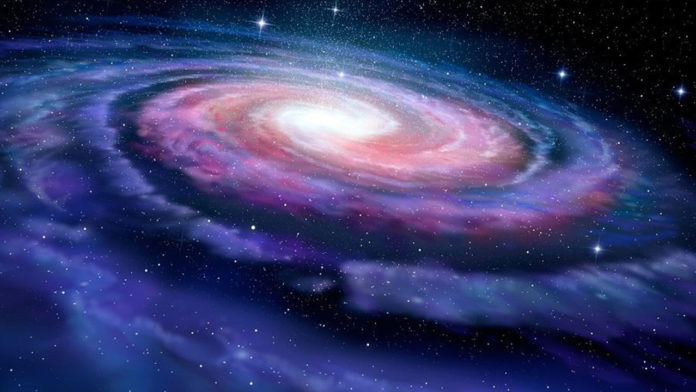The LMC, presently a satellite galaxy of the Milky Way, is visible as a faint cloud in the southern hemisphere’s night skies. Past study has unveiled that the LMC, like the Milky Way, is surrounded by a halo of dark matter.
As scientists believed, the LMC crossed the Milky Way’s boundary around 700 million years ago. And because of its large dark matter content, it strongly upset our galaxy’s fabric and motion as it fell in.
The spiral-shaped disc of stars and planets is being pulled, twisted, and deformed with extreme violence by the gravitational force of a smaller galaxy – the Large Magellanic Cloud (LMC).
In a new study, scientists from the University of Edinburgh discovered how the LMC warped our galaxy’s motion. They used a sophisticated statistical model to calculate the speed of the Milky Way‘s most distant stars.
They found that the LMC’s dark matter halo’s enormous attraction is pulling and twisting the Milky Way disc at 32 km/s or 115,200 kilometers per hour towards the constellation Pegasus.
Surprisingly, the study also revealed that the Milky Way was not moving towards the LMC’s current location, as previously thought, but towards a point in its past trajectory. This might be because the LMC, powered by its massive gravitational force, moves away from the Milky Way at an even faster speed of 370 km/s, around 1.3 million kilometers per hour.
Astronomers noted, “it is as if the Milky Way is trying hard to hit a fast-moving target, but not aiming very well.”
Dr. Michael Petersen, Lead author and Postdoctoral Research Associate, School of Physics and Astronomy, said, “Our findings beg for a new generation of Milky Way models, to describe the evolution of our galaxy. We were able to show that stars at incredibly large distances, up to 300,000 light-years away, retain a memory of the Milky Way structure before the LMC fell in, and form a backdrop against which we measured the stellar disc flying through space, pulled by the gravitational force of the LMC.”
Professor Jorge Peñarrubia, Personal Chair of Gravitational Dynamics, School of Physics and Astronomy, said, “This discovery breaks the spell that our galaxy is in some equilibrium state. The recent infall of the LMC is causing violent perturbations onto the Milky Way. Understanding these may give us an unparalleled view on the distribution of dark matter in both galaxies.”
Astronomers now intend to find out the direction from which the LMC first fell into the Milky Way, and the exact time it happened. This will reveal the amount and distribution of dark matter in the Milky Way and the LMC with unprecedented detail.
Journal Reference:
- Petersen, M.S., Peñarrubia, J. Detection of the Milky Way reflex motion due to the Large Magellanic Cloud infall. Nat Astron (2020). DOI: 10.1038/s41550-020-01254-3
